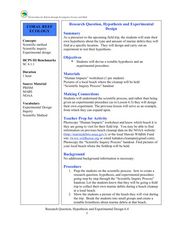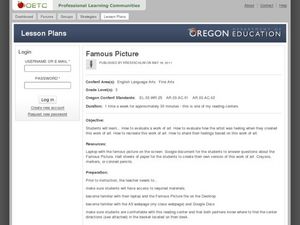Curated OER
Research Question, Hypothesis and Experimental Design
Students discuss steps of the scientific process, as well as, observe a picture of the beach that they will visit. Students create a testable hypothesis about marine debris at the beach. In this science lesson plan, students create a...
Curated OER
What a Character !
Students identify traits associated with a character in a biography. In this character analysis lesson, students select a biography and discuss character traits. Students complete a related worksheets and complete a character description...
Curated OER
Tracing the Idea of Civil Disobedience through Thoreau, Gandhi, and King
Students analyze civil disobedience through history studying Thoreau, Gandhi, and Dr. King. In this civil disobedience lesson, students read and analyze excerpts from Thoreau, Gandhi, and Martin Luther King. Students demonstrate their...
Curated OER
The Tell - Tale Heart
Students read The Tell Tale Heart and practice critical analysis while reflecting on its underlying meanings. In this reading activity, students make predictions, monitor their own comprehension and adjust their reading accordingly....
Curated OER
Creating a Spreadsheet
Students create a spreadsheet using ICT. In this algebra lesson, students collect and graph their data using a spreadsheet. They find solution to a given problem using trial and error.
Curated OER
Slavery
Students use primary and secondary source documents to look into the story of slavery told about "Pink". The original documents like a bill of sale for the slave is used for example. The students write notes about the research and think...
Curated OER
A Brief History of Fairfax County
Students begin the lesson by writing what they know about Fairfax County in their journals. Using primary source documents, they identify ten interesting facts about the area and watch a video. They complete a Venn Diagram comparing...
Curated OER
This Just In: Exploreer Neets Wabanaki Indians
Students engage in a research of the Wabanaki Indians using a Social Studies textbook. Then the teacher reviews the information with the students. Then they work in groups to decipher the meaning of a primary source document and write a...
Curated OER
Activity 10: Primary and Secondary Sources
Students sort documents into primary and secondary sources and analyze their reliability. In this history research lesson, the teacher gathers a selection of document images, then discusses primary and secondary sources and their benefits.
Curated OER
The Struggle to Organize
Students analyze correspondence and a news release regarding the Harlan, Kentucky, mine strike of 1931-1932. They use these documents to discuss the problems of organizing industrial trade unions before the New Deal.
Curated OER
Using Primary Documents: The 1906 San Francisco Earthquake
Students examine primary documents from various key historical events, including those from the 1906 San Francisco earthquake. They discuss the importance of such documents.
Curated OER
The Evolution of the Preamble
Reading and comprehending informational text is vital in all subject areas. Upper graders use primary sources and worksheets to better comprehend the historical importance of the Preamble of the US Constitution. Web links, handouts, and...
Curated OER
Who is on that Bill? Alexander Hamilton and the Federalist Papers
Students, who are adult learners, participate in an Internet scavenger hunt in order to assimilate information about the biography of Alexander Hamilton and the Federalist Papers. They look at the Federalist and Anti-Federalist Papers...
Curated OER
Mapping My Spot in History
Young scholars create their own town's history. They place themselves on the map in a literal as well as figurative sense. Students produce portions of an updated version of an early twentieth century panoramic map. Young scholars gather...
Curated OER
Famous Picture
Art is a thoughtful and beautiful to motivate students in so many subjects. This lesson has students practice basic computer skills while examining a famous piece of art. They consider the color, style, and feeling of the piece. A...
NASA
Lights on the International Space Station
Groups explore illumination with NASA's Lighting Environment Test Facility (LETF) as a context. Using the TI-Nspire app, groups determine the lux equation that models their simulation. They then use the lux equation to solve problems...
Code.org
Bytes and File Sizes
A bite of bits. The first lesson in a unit of 15 introduces the class to the byte. Pupils learn about other standard units for measuring file sizes, develop an understanding of relative sizes and the kind of units used to measure...
Curated OER
Concept Formation Lesson Plan: Understanding "Protest"
After analyzing both examples and non-examples of a variety of protests conducted by ethnic groups in Seattle and the state of Washington during the twentieth century, your class members will work to identify the key ideas and components...
Museum of Tolerance
Can It Happen in America?: Taking Social Action
Class members investigate the Jim Crow Laws, Executive Order 9066, the Chinese Exclusion Act, and the Indian Removal Act to gather information about not only the challenges encountered by diverse groups of Americans, but their...
C-SPAN
Polling and Public Opinion
Most people are eager to offer their opinions about topics of interest, but what's the most effective way to collect and assess these opinions as a matter of fact? High schoolers learn about the history of polling, as well as the...
National Woman's History Museum
Inventive Women - Part 2
The Declaration of Independence was published in 1776. The Declaration of Sentiments and Resolutions, modeled after the Declaration of Independence, was drafted and read by Elizabeth Cady Stanton at the Seneca Falls Convention in 1848....
Smithsonian Institution
Us vs. Them: The Chinese Exclusion Act of 1882
Immigration issues are nothing new. An interesting instructional activity focuses on the racially motivated Chinese Exclusion Act of 1882 and its impact on the Chinese American community. Scholars read articles, analyze political...
Smithsonian Institution
A New America: The Hart-Celler Immigration Act of 1965
Many dream of coming to America, but few may enter. The lesson explores the Hart-Celler Immigration Act of 1965 and how it changed immigration policies in the United States. Academics learn how immigration quotas impacted Western Europe...
Museum of the American Revolution
George vs. George
It's George versus George in the battle for the American colonies. An interesting activity compares the leadership of George Washington and King George III during the American Revolution. Scholars read text, compare portraits, and...
Other popular searches
- Poetry Analysis Document
- Document Analysis Sheet
- Primary Document Analysis
- Forensic Document Analysis
- Written Document Analysis

























